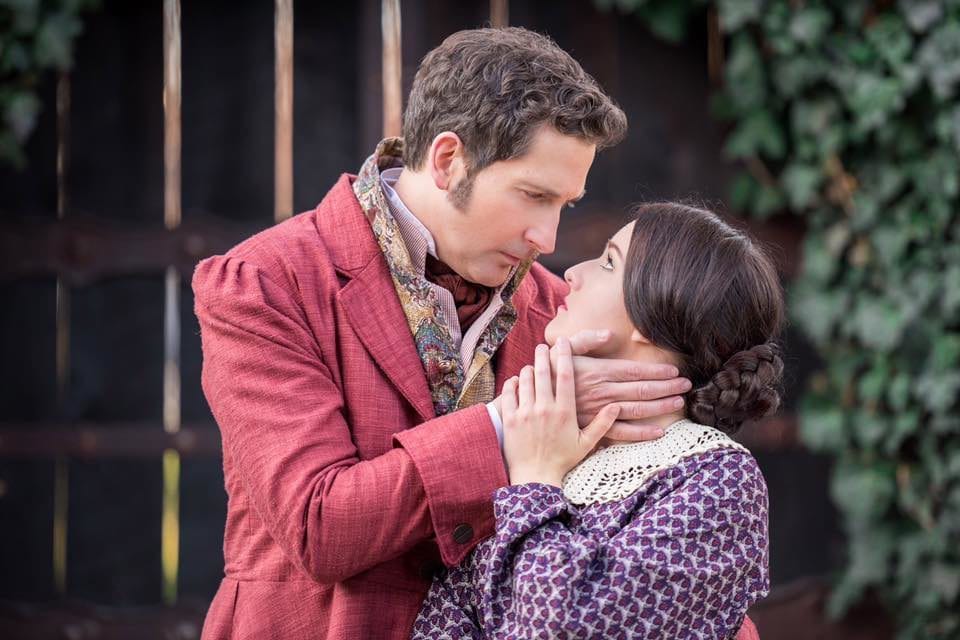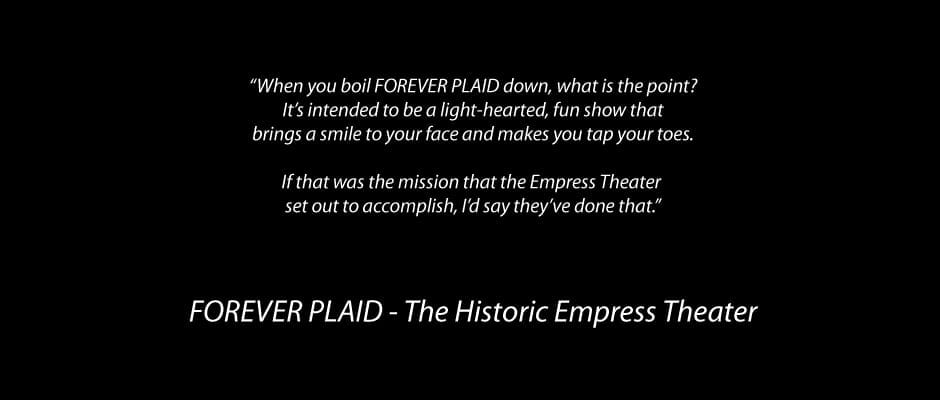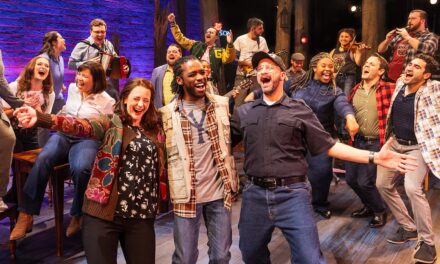OREM — Given Utah audiences’ love of musicals, Victorian Gothic romance, and period costumes, the musical version of Jane Eyre, now playing at Hale Center Theater Orem, should be more of a fixture in the local theatre scene than it is. However, chances are you have never heard of it—and there is a good reason for that. When even the combined (and considerable) talents of HCTO’s production team, director Christopher Clark, and star Dallyn Vail Bayles cannot salvage this ponderous, lurching adaptation by Paul Gordon (music and lyrics) and John Caird (book), any theatre company would be wise to keep its distance.

Show closes June 4, 2016.
Though the script streamlines some details, the overall contours of Charlotte Brontë’s 1847 novel of the same name make the transition to the stage with few alterations. The orphan Jane (played by Laura Randall as a young girl and Kenna Lynn Smith as an adult) is abandoned by her Aunt Reed (Heather Shelley) at Lowood School, where her friendship with Helen Burns (Rachel Peterson) helps her learn to face the harshness of life without bitterness. Eight years later, Jane leaves Lowood to take a position as a governess to the ward of Edward Fairfax Rochester (Bayles), lord of Thornfield Hall. At Thornfield, Jane enjoys the company of the housekeeper, Mrs. Fairfax (Lynne D. Bronson), her charge, Adele (Alyssa Buckner), and eventually Mr. Rochester himself, whom she comes to love. However, strange occurrences, such as a suspicious fire in Rochester’s bedroom, eerie laughter echoing through the halls, and a visit from the mysterious Richard Mason (Patrick Kintz), all hint that there is trouble on the horizon for Jane’s burgeoning happiness.

Dallyn Vail Bayles as Edward Fairfax Rochester.
In addition to the novel’s gothic attributes and interclass romance, Jane Eyre has long enjoyed critical attention for its feminist themes (kudos to the program notes for alluding to this). The musical, to its credit, attempts to place this aspect front and center: In “Sweet Liberty,” Jane asks that “tradition give way” so that women’s “worth,” rather than their gender, can “define [their] roles.” Regrettably, however, Gordon’s recurring metaphor of choice for society’s confining roles is a captive bird—an image so overused (and better used by others) that it completely undermines the idea it represents. Instead of highlighting Jane’s independence within a patriarchal culture, it relegates her strength to a cliché, ensuring that it has as little impact on the listener as possible. Lest anyone complain that, in the novel, Rochester does indeed call Jane a trapped bird on more than one occasion, let me point out that Jane forcefully rejects the comparison. She counters that she is “no bird,” but “a free human being”—which makes Gordon’s translation of the image into yet another anthem about yearning to fly particularly ill-advised.
The leitmotifs in the score suffer from a similar problem. In principle, the repetition and development of themes tied to characters and ideas is part of what enhances a musical’s texture and overall coherence. However, in Jane Eyre, the effect is more like Rochester’s description of love—a virus. Melodies and figures self-replicate too often and too conspicuously, fatiguing the ear and, like the bird cliché, rendering them meaningless.

Speaking of meaninglessness, many of the lyrics are as guilty of this as the music. When Jane refers to herself (yet again) as a bird “upon the brief,” I am still trying to figure out what that is, just as I have yet to conceptualize how a musical cadence—whose role is harmonic resolution—can, in the words of Blanche Ingram, “float.” Why does Rochester “damn the skies,” exactly, beyond the fact that it rhymes with “the light that’s in her eyes”? Isn’t there a more motivated rhyme for two lives “fused as one” than the banal “another day is done”?
What’s worse are the lyrics that have meaning, but of the wrong sort. Rochester has a particular talent for this. To return to his idea that love is a “virus,” both he and Jane sing that it has “infected every wound and every pore.” I concede that this is a subjective question, but infected pores are not my idea of lyrical symbolism. At the end of the first act he goes even further, deftly combining a stale trope with inapt usage, when he describes Jane as a “siren.” Because the Greeks often portrayed the sirens as some form of bird, you could say that it’s consistent with Gordon’s avian obsession, but how is that a positive? Still, of all the inappropriate characterizations one could inflict upon Jane Eyre, I suppose this one is at least indicative of the misogynist culture of Rochester’s upbringing.
I could go on. The piano vamping in “Secret Soul” makes me feel as if I’m listening to a Frank Wildhorn who has forgotten how to write a hook. Poor Mrs. Fairfax is apparently only allowed to sing scales. Nevertheless, believe it or not, the score is not wholly bad; it’s a mixed bag, really.
Yet even if it were brilliant, it would make no difference because HCTO has crippled it with a cringe-inducing synthesized orchestral track. I cannot overstate how much this one production element sabotages and cheapens every other aspect of the show. For example, the script gallops through a fair amount of exposition in some places to be able to stretch out more character-driven moments, like some of the duets. In theory, this can even be a good thing, if properly executed. However, every opportunity for subtlety, grace, or subtext in the actors’ performances that might justify this approach is trampled by a stampede of poor quality string pads, whiny reeds, robotic vibrato, and hokey electronic drums. It is hard to take a developing romance seriously when the musical accompaniment sounds like bad 1990’s karaoke. I assume HCTO is recycling material from its 2004 production of the show, but it falls light years short of the standards an audience expects from any Hale-branded production in 2016. This alone is a deal-breaker and should have been resolved before Jane Eyre ever made it onto the season calendar.
It’s a terrible shame, because the many positive qualities of the production simply cannot compete. I typically do not care much for projected backgrounds, but I enjoyed the moving images designed by Cole McClure. They are representative of the creativity and innovation that HCTO’s challenging space can stimulate. In what reminded me a little of Sam Buntrock’s revival of Sunday in the Park with George, the connection to Jane’s sketchbook through the drawing and watercolor aesthetic of the visuals added an extra dimension to both Jane and her surroundings.
I have nothing but praise for Christopher Clark’s direction, which is actually rather damning since it demonstrates how tenaciously Jane Eyre resists improvement. Clark kept the pace brisk, the performances committed, the transitions seamless, and the blocking motivated. I’ll admit, however, that between this production and last year’s Ghost at HCT West Valley, I’m beginning to wonder if he has a weakness for doomed properties.
The actors do put in a lot of earnest work and, though there were some unfortunate (and exposed) pitch and range problems here and there, the singing was, by and large, competent. Bayles provided most of the highlights in that department, of course, though—again—even his exceptional voice could not overcome the flaws in the score and instrumental track. I did find his Rochester a little too glib and gregarious for my taste. But there might have been more pathos there than I could sense through the numbing, mechanical fog of the music. The same goes for any chemistry between Rochester and Smith’s Jane Eyre, whose poise and honesty I admired, but who likewise faced an uphill battle with the material.
Rochester remarks at one point that if Jane were ever to talk “nonsense,” it “would be done so gravely [he] should mistake it for sense.” He might as well have been reviewing Gordon and Caird’s adaptation of Jane Eyre. If the instrumental track has a silver lining, it’s that it at least serves to guard against confusing Jane Eyre‘s somber tone with substance.
Correction: This review originally included a comment about the song “My Maker” in its analysis of the score. Since HCTO’s production omits this song, this observation has been removed.




